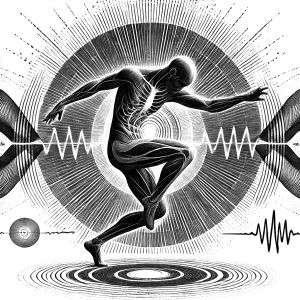InnerMotion – The Guidebook – Core Impulse

The Core Impulse is a natural way to initiate dance from your body’s center - the abdomen, back, and pelvic region - often regarded in martial arts and somatic practices as the primary power source. Anthropological and neuroscientific research suggests that our drive to move rhythmically in response to music is deeply woven into our genetic makeup, evolving to enhance social cohesion and communication across human history. One aspect of music that compels movement is its beat - repeating pulses that we predict and entrain to through interconnected brain regions (e.g., the auditory cortex, basal ganglia, and cerebellum), collectively “locking in” our bodies to the rhythm. By syncing your core with the beat, you tap into an intrinsic flow of energy, making movement feel effortless and connected. This is not just instinctual - it’s a deep-seated human impulse, shaped by evolution to enhance movement, bonding, and expression.
How to Practice
- Tune into the Music: Begin by clearly feeling the beat and groove of the music. Using layered listening, previously explained in the Music Focus section, find the fundamental beat - usually a steady drum, bass, or consistent rhythm together with possible secondary rhythms such as the offbeat hi-hat.
- Ground Through Your Feet: Stand comfortably with feet hip-width apart, knees slightly bent. Feel the soles of your feet connecting firmly to the floor. This grounding provides stability for the rest of your body to respond dynamically.
- Activate the Core: As you inhale, allow your lower belly to expand naturally. As you exhale, gently engage your abdominal and lower back muscles - not by clenching, but by sensing a subtle lift from your pelvis and lightly pulling your down belly inward and upward. Imagine your breath activating your center, creating a steady, energized support.
- Start to "Bounce": With the music's beat in mind, start a gentle bounce by softly bending and straightening your knees in rhythm. Imagine your legs as springs, absorbing and releasing energy like you’re standing on a soft trampoline - each downward motion absorbs energy, and each upward motion releases it. Each downward motion is a subtle energy gathering, and each upward motion is an effortless release, creating a rhythmic pulse. Feel a feedback loop form between your feet, knees, and hips - this continuous loop is your basic groove, ensuring you dance "in time" with the music.
- Engage the Upper Body: Introduce your torso and shoulders into the movement, using them as counterbalances. As your hips naturally respond to the bounce, let your torso sway or gently twist, maintaining balance and adding expressive dynamics. Allow your shoulders to remain relaxed and responsive, and feel how the torso’s subtle movements enhance the rhythmic bounce generated by your lower body.
- Expand Movement Outward: Allow the movement to travel further through your body. Let your arms and hands follow naturally, expressing rhythmically and freely without tension. Include head movements gently - nods, tilts, or subtle rotations in sync with the overall rhythm.
- Move Through Space: Once you've established a comfortable internal rhythm, begin moving through your dance space. Start with small, rhythmic steps connected directly to your core’s pulses. Experiment with directions - forward, backward, sideways, diagonally, or in circular patterns.
- Enter the Flow: As your core consistently guides your movements, you’ll find yourself naturally transitioning into a flow state. Movements become intuitive, connected, and expressive. Trust your body’s innate rhythm, letting go of conscious control. Experience your dance as a seamless, energized expression from within. At some point, the music and your movement will feel inseparable - as if your body is riding an invisible current. You’re no longer ‘doing’ the dance; you’re simply in it.
Tips
- Stay Relaxed: Regularly check for and release unnecessary tension, especially in your jaw, shoulders, and hands.
- Focus on Breath: Allow your breath to sync with your movements - steady, deep breathing helps maintain ease and enhances rhythm.
- Trust the Process: Be patient; initially, your movements might feel small or subtle. With practice, your core-led impulses will naturally expand, becoming more pronounced and expressive.
- Play and Explore: There’s no single “right” way to move - try bigger or smaller bounces, shifting weight, playing with tempo. Explore how different musical styles make your core respond.
- Pause When you Lose Focus: Whenever distractions (like thoughts or muscle fatigue) arise, pause for a moment, and then gently refocus on your core. Let them shepherd you back into a free-flowing groove.
Why It Works
- Stored Kinetic Energy: Your legs and core act like a spring. Each soft bend absorbs energy, and each release rebounds effortlessly. Instead of forcing movement, you let stored energy do the work. This reduces fatigue, making your dance more sustainable - so you can move for hours with ease.
- Biomechanical Efficiency: Your core is your balance center - when movement starts there, the rest of your body follows effortlessly. If you try to dance from just your arms or feet, movement feels disconnected. Core-led movement creates unity, fluidity, and ease.
- Connection to Rhythm: The brain naturally entrains to rhythm, meaning your body wants to sync with music. By locking into the beat from your core first, you make the groove feel natural rather than forced.
- Movement Feels More Expressive: When you stop forcing steps, dance becomes a conversation between you and the music. Your body can respond playfully, adapting to different beats, tempos, and moods.
Core Impulse invites a sense of unlimited energy and seamless musical connection. By centering your attention and movement in the core at the start, you cultivate a dance that feels less like physical labor and more like riding an internal wave of momentum. This fosters a deeper, more intuitive union with the music and a gratifying sensation of freedom in every step.